It has been a minute and a lot has happened in the time since I made my last post.
Here’s what I recorded for the week of 9/14:
- 9/15/20
I missed writing about my starters yesterday but I’ve switched to a 12 hour schedule. In my last blog post I mention how a hooch grew in a period shorter than the 48 hours it took for it to form the last time. The habanero smells extremely similar to kombucha, but the control is less so. The control has a more dry, floury smell.
Photos from last couple of days:
 Habanero starter with hooch
Habanero starter with hooch
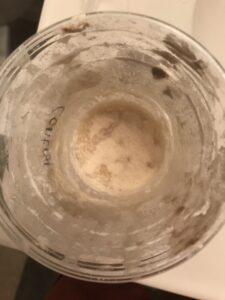

 Control starter with small hooch
Control starter with small hooch



 Habanero starter after feeding
Habanero starter after feeding
 Control starter after feeding
Control starter after feeding
- 9/18/20
I really don’t feel great, I’m super busy and I’ve been traveling so my yeasty bois look like crap. When I opened them this morning the hooch had not grown. (I missed a feeding on the 16th but other than that I’ve been pretty good about it). They were just full of liquid. It’s my fault. I was traveling from Burlington back to Raleigh while the sun was rising, so it was directly on them. Unfortunately I did not think to cover them with a shirt I had in my car until I was only 15 minutes from my apartment and I observed condensation on the lid of each cup. So that’s not great at all really.
Here are the photos, I could definitely have taken better and I’m not sure what I was doing that night:

 Habanero starter
Habanero starter
 Habanero starter
Habanero starter
- 9/19/20
They look and smell better than they did the other day. Pretty much the same smells, my habanero starter is most similar to the smell of kombucha while the control smells like a doughy, dry kombucha. When I was on my original 24 hour schedule I fed them every day at 10:16 pm; this hasn’t changed but now I also feed them at 10:16 am. I’m aware that I could feed them at a more reasonable time at night but I’m a person who needs a lot of structure so it helps to not change things up much, and I typically end up working until 10:16 pm each night anyway so I’m not missing out on any sleep. Here are my photos:


 Habanero starter
Habanero starter
 Control starter
Control starter
2. This week was a little challenging because I had to travel and switch to the 12 hour schedule but it wasn’t that bad.
3. Here are the results of my rising rate experiment:
GN 312 graph 1 growth GN 312 Percent Increase Over Time Graph
GN 312 Percent Increase Over Time Graph
4. The habanero hails from the Amazon river basin, and intact pods dated to 6,500 BC have been found in the region. The early habanero was initially similar to a wild chile pequin; after its discovery it was quickly domesticated and by 1000 BC it had become a valuable trade item among the indigenous American cultures and was almost identical to the wonderful chili we have now. It is said that the reason chilies are referred to as peppers (when they are really quite different) is the fault of Christopher Columbus himself, who mistakenly believed the habanero was closely related to the bell peppers he was familiar with (with how horrible a person he was I can only hope that his first encounter with this fiery fruit was extremely unpleasant). Nevertheless, once the Spanish colonized the region the habanero began to explode in popularity (an explosion that continues to the present day: https://www.youtube.com/watch?v=1uNpjqH-mQQ the video may cover the Carolina Reaper but the cultivation of super-hots is such a recent phenomenon that nearly all chilies are still technically the same species as the habanero). In fact, it became so widespread that when European taxonomists attempted to fit it in their scientific nomenclature they named it Capsicum chinense under the mistaken belief that it was from China.
Nowadays habaneros are primarily harvested in the Yucatan peninsula, where the humidity, heat, and sun all combine to produce some of the finest habaneros in the world. One popular bread made in the region is Conchas, a sweet bread roll. Conchas is actually very similar to sourdough, and even utilizes sourdough starters in its production.
I’m about a week behind in terms of sourdough growth so I’ve continued to document their phenotypes:
9/20/20
I’ve been traveling today and they look predictably bad. It’s a bit better than last time but it’s not ideal. They’re both mostly liquid. They both smell more like bread, which is new and interesting. The habanero starter still smells somewhat of kombucha but it isn’t as strong as it was.



What the habanero starter looks like after travel


Control starter 9/20
9/21/20
Their smells are both back to normal. The habanero starter smells tangy and like kombucha, while the control does to a smaller degree.
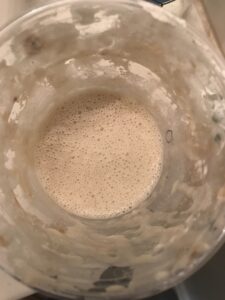 The habanero starter 9/21
The habanero starter 9/21
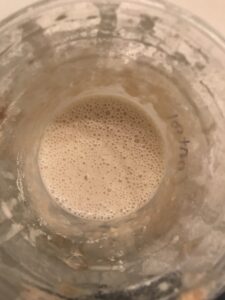
The control starter 9/21
9/22/20
They both smell more like bread. It’s not fully there, but the kombucha and tanginess I’ve reported has dissipated a little and been replaced by a doughier smell that smells not far from sourdough. I guess I shouldn’t be surprised haha. The similarity to kombucha is still there but it’s weaker.
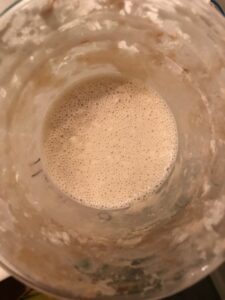

Habanero starter 9/22
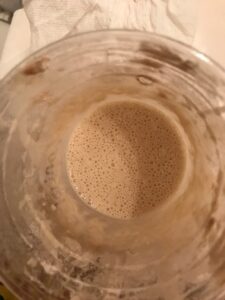

Control starter 9/22
9/24/20
I noticed mold on the surface today. It still smells like kombucha and sourdough but now there’s a moldy smell too. I can’t believe I’m saying this but it smells gross. It’s funny because 2 months ago I wouldn’t have put my nose anywhere near this cup regardless of whether or not there was mold–and yet I’ve grown so acclimated to its usual smell that it doesn’t even gross me out now.
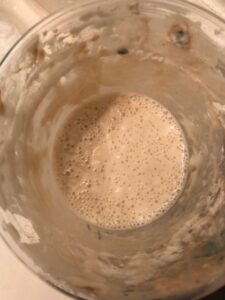


Habanero starter after feeding 9/24/20
9/25/20
There was mold atop the surface again. It smells more like sourdough bread than it did before.
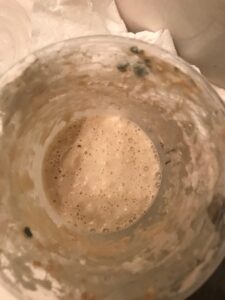


My habanero starter 9/25/20
I’m not sure why I didn’t take more photos of the control starter this week. Nothing bad has happened to it I just guess I was tired or not paying attention and failed to take its photo.
- Because we’re concerned with what microbial communities are in each of our starters, we can’t use genotypic data. Rather, we must use DNA sequencing so that we can determine what species of microbes are present and what are associated with fast rising.
- I definitely learned about DNA sequencing in my previous biology classes, but it has been a long time since I took them so I’ve mostly forgotten what I learned. That said, I do watch a lot of evolution content on YouTube, and recently watched a video about the Loch Ness monster and how eDNA (and a ton of other data) disproves its existence.
- The main difference between Sanger sequencing and NGS is sequencing volume. NGS is far more effective, and can sequence millions of fragments per run while Sanger sequencing can only manage a single fragment at a time. NGS also allows us to compare many fragments simultaneously, while Sanger was more like a snapshot of one spot. Computerization has certainly allowed for NGS to become mainstream.
- What specific NGS technology are we using in this class? From the short video about this technology, what did you understand about how it works? What parts of the video left you confused?– Basic criteria: Discuss what you understood and what you didn’t understand from the Illumina sequencing video. Again, it’s okay to discuss in non-technical terms. This is very complex, and to fully understand this would require background knowledge that many of you don’t yet have based on the courses you’ve taken so far.
We’re using the iSeq 100 Sequencing System. I get the basic steps, and it helped me a lot to pause the video and write down each step. I basically understand the broad ideas but the video constantly used vocabulary that went right over my head I mean I don’t even know if I can spell oligose correctly. But that’s really where my main issues lie, just the vocabulary. I kind of understand how in both cluster generation and in sequencing how strands are replicated but I have absolutely no concept of how this actually occurs. “Clonally amplified” and “Index reed primer” mean almost nothing to me. But the illustrations helped a lot. If this wasn’t a video and it were instead a series of paragraphs in a textbook I would have a much harder time understanding the basics. The sample prep section wasn’t really that bad and was certainly more comprehendible than the following 2 sections but I still had issues with the vocabulary used.
Sources:
http://www.habaneromadness.com/history-of-the-habanero-pepper.html#.X2_FsGhKg2w
https://www.chilipeppermadness.com/chili-pepper-types/hot-chili-pepper-types/habanero-chili-pepper/
